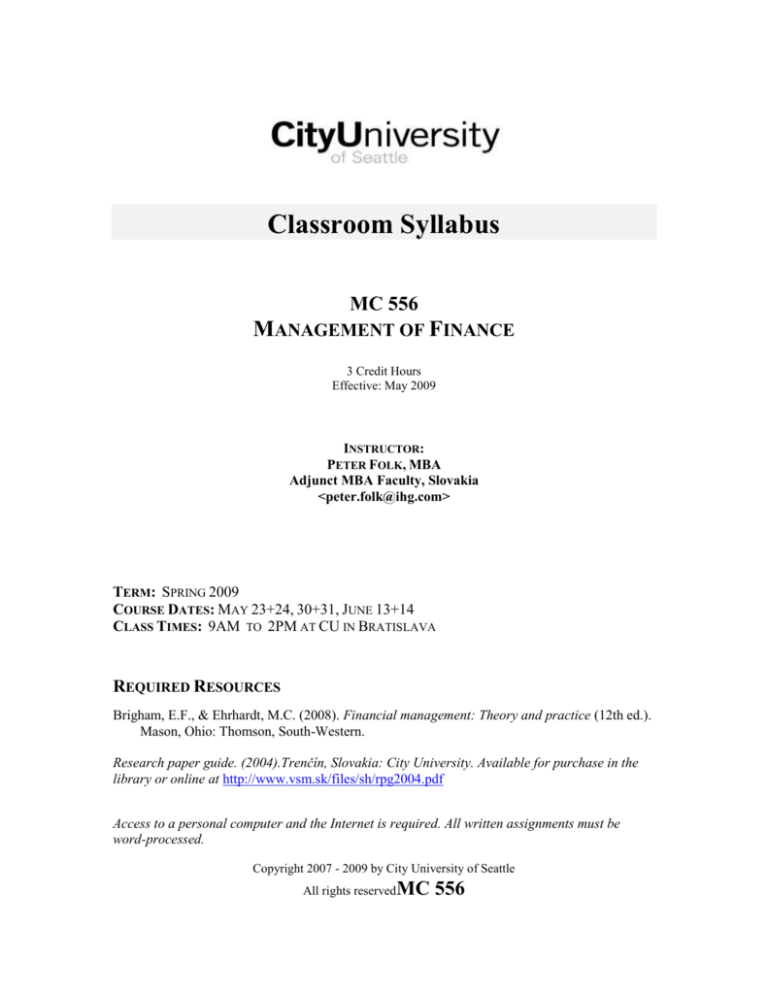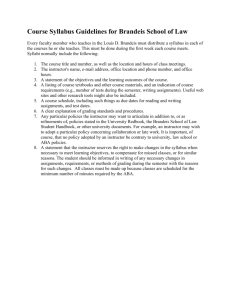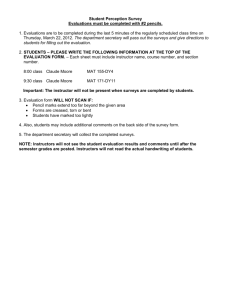
Classroom Syllabus
MC 556
MANAGEMENT OF FINANCE
3 Credit Hours
Effective: May 2009
INSTRUCTOR:
PETER FOLK, MBA
Adjunct MBA Faculty, Slovakia
<peter.folk@ihg.com>
TERM: SPRING 2009
COURSE DATES: MAY 23+24, 30+31, JUNE 13+14
CLASS TIMES: 9AM TO 2PM AT CU IN BRATISLAVA
REQUIRED RESOURCES
Brigham, E.F., & Ehrhardt, M.C. (2008). Financial management: Theory and practice (12th ed.).
Mason, Ohio: Thomson, South-Western.
Research paper guide. (2004).Trenčín, Slovakia: City University. Available for purchase in the
library or online at http://www.vsm.sk/files/sh/rpg2004.pdf
Access to a personal computer and the Internet is required. All written assignments must be
word-processed.
Copyright 2007 - 2009 by City University of Seattle
All rights reserved
MC 556
MANAGEMENT OF FINANCE
This document provides an overview of the course foundation elements, assignments, schedules
and activities. For information about general City University policies, please see the City
University catalog. If you have additional questions about the course, please contact your
instructor.
Notification to Students with Disabilities
If you are a student with a disability and you require certain help, please contact the site
administrator as soon as possible.
COURSE DESCRIPTION
The course covers further topics in corporate financial management, including analysis of
financial statements, financial planning and forecasting, corporate valuation, strategic financing
decisions (capital structure decisions, dividends and repurchases), tactical financing decisions
(initial public offerings, financial restructuring, lease financing, hybrid financing), working
capital management, derivatives and risk management, bankruptcy, reorganization, and
liquidation, mergers and LBOs, and multinational financial management.
LEARNING GOALS
Upon the successful completion of this course, you will be able to:
1. Assess a firm’s financial performance and condition and do financial statement forecasting;
2. Perform corporate valuation;
3. Review the determine the optimal capital structure and understand capital structure theory in
more detail;
4. Understand distributions to shareholders, including dividends and repurchases;
5. Understand initial public offerings and financial restructuring
6. Understand other financing decisions including lease financing and hybrid financing
(preferred stock, warrants, and convertibles);
7. Perform effective working capital management - including cash, accounts receivable,
inventory, short-term investments and short-term financing;
8. Use derivatives to reduce risk;
9. Analyze financial distress and its consequences, reorganization and liquidation in bankruptcy;
10. Analyze the conditions for, process, and results of mergers, leveraged buyouts, and
divestitures;
11. Compare and contrast multinational and domestic financial management.
MC 556
SYL
Page 211
Eff: 05/09
CORE CONCEPTS
To achieve the goals of this course, you will need to master the following core concepts:
1. Financial ratio analysis; the Dupont equation; financial statement forecasting;
2. Corporate valuation model;
3. Optimal capital structure and capital structure theory in general;
4. Dividends and repurchases; stock splits and stock dividends;
5. Initial public offerings and financial restructuring;
6. Lease financing;
7. Hybrid financing, including preferred stock, warrants and convertibles;
8. Working capital management;
9. Derivatives and risk management;
10. Bankruptcy, reorganization, and liquidation;
11. Mergers, LBOs, and divestitures;
12. Multinational financial management.
ENTRY COMPETENCIES
A prerequisite for enrolling in this course is completion of MC 553 (Principles of Finance) or
evidence of an equivalent knowledge of finance.
RECOMMENDED SUPPLEMENTARY RESOURCES
As a City University of Seattle student, you have access to library resources regardless of where and how
you are taking this class. To access the resources necessary to complete your coursework, visit the library
menu in the My.CityU portal at https://my.cityu.edu, and the CU Slovakia library home page at
http://library.cutn.sk/.
A good place to begin your research is through the management program resources page in the
My.CityU library. It provides links to relevant journals, books, and Web sites. Search the online
databases for journal, magazine, and newspaper articles. For additional help, visit the Slovakia
library or submit your question in the Contact Us section of the Slovakia library’s web site.
ELECTRONIC RESOURCES
The following Internet resources may be of use to you in this course. Many other useful Web
addresses are provided in the textbook. Please be aware that Web addresses may change from
time to time.
City University of Seattle
http://my.cityu.edu
Financial news:
MC 556
SYL
Page 311
Eff: 05/09
http://finance.yahoo.com
http://www.thestreet.com
http://money.cnn.com
Journal of Finance
http://www.cob.ohio-state.edu/dept/fin/journal/jof.htm
The Wall Street Journal Online
http://www.wsj.com
United States Securities and Exchange Commission (includes EDGAR database of
company annual reports)
http://www.sec.gov/index.html
Wall Street Research Net
http://www.wsrn.com
OVERVIEW OF COURSE ACTIVITIES AND GRADING
The grade you receive for the course will be derived using City University’s decimal grading
system, based on the following:
Assignments
Case Study
Financial News Analysis - Presentation
Final Examination
30%
30%
40%
TOTAL
100%
Please see the current City University catalog or consult your instructor for guidance in
determining your decimal grade.
EXPLANATION OF ASSIGNMENTS AND GRADING
CASE STUDY
Your instructor will provide this graded case assignment. You should treat it as a problem
presented to you by your company’s top management for analysis and decision recommendations.
Hence, your paper should demonstrate the qualities of thorough and relevant research, logically
sound analysis, and focused professional writing. For each question about the case, clearly
indicate which question you are answering, and show all computations (where applicable) to
support your conclusions. Where assumptions must be made, state and justify them clearly. Your
instructor may also give you some guidance on the assumptions you should make.
Grading Criteria for Case Study
Demonstrated understanding of relevant course concepts
Clarity of explanations
Completeness and accuracy of calculations
Logically supported conclusions
MC 556
SYL
Page 411
20%
20%
20%
25%
Eff: 05/09
Professional presentation (including language and format)
15%
TOTAL
100%
FINANCIAL NEWS ANALYSIS
This assignment is designed to (a) stimulate you to find out what is happening in the financial
world today by reading current newspapers and magazines, (b) help you to learn the course
material by seeing how it applies to real companies, events, and situations, and (c) challenge you
to analyze and evaluate financial news so that you can form your own opinions.
Steps:
1. Go to your local library or visit the City University on-line library and review recent issues
(published within the past 30 days) of the following periodicals: (a) The Wall Street Journal
or (b) Business Week magazine. (Articles from these sources’ websites are permissible, but
they may require subscription to access the articles on-line.). Look for news articles that (a)
related to topics covered by the MC556 course and (b) raise interesting issues about company
financial management. Try to find an article that will help you do well on the trading criteria
for the assignment (listed below). Check with the instructor to make sure that an article you
found is appropriate.
2. Prepare a brief summary of your findings and present it to the class. It should take you no
more than 10-15 minutes to present your conclusions. Visual materials are required Microsoft PowerPoint presentation is strongly recommended. You will be expected to turn
your presentation in. The format is to be appropriate for a Board of Directors or a venture
capitalist. Additional criteria will be provided by the instructor, but your presentation should
primarily:
Explain the news item (the event and why the newspaper or magazine thought it was
newsworthy)
Give some facts about the companies and people involved (you may have to do some
further research beyond the news article itself)
Explain the connection between the news article and the MC 556 course
Identify key actions or decisions described in the news item and evaluate them, giving
your own opinions and your reasons
3. You must have a photocopy of the original news items, showing the date of publication
available at the time of presentation.
Grading Criteria for Financial News Presentation
Choice of news article (relevance, importance, interest)
Clarity of explanation of the news item
Explanation of the connection to the course material
Analysis and evaluation of the issues relating to financial management
Professional demeanor
Capacity to handle questions and feedback
Grammar, spelling, punctuation, and clarity of visual materials
20%
15%
10%
20%
15%
10%
10%
TOTAL
100%
MC 556
SYL
Page 511
Eff: 05/09
ADDITIONAL REQUIREMENTS FOR ASSIGNMENTS
HOMEWORK ASSIGNMENTS
To achieve the learning objectives of this course, you will need to understand key concepts and
also to be able to perform calculations to solve certain types of financial problems. It is very
important to do homework outside of class, even though the assignments are not graded. An
effective strategy would be:
1. For each week of the course, start by reading the assigned chapters of the textbook. Test
your basic understanding of the concepts by reading each chapter summary.
2. Answer the practice questions and problems listed as homework in the recommended
course schedule.
3. Use the online study guide and other learning resources on the textbook website to
enhance and further test your understanding.
Solutions to the practice questions and problems for homework are provided. However, you will
learn best if you first attempt to answer them on your own before checking the solutions. For
additional practice, do more problems of the same type.
PROFESSIONAL PRESENTATION OF WRITTEN WORK
All assignments submitted for this course should be of professional quality. The student should
present each paper in a format that would be appropriate for submitting to upper management.
This course requires that you use the American Psychological Association (APA) style in
preparing any written work where other sources are used. A recommended style guide is
included in the “Required Text and Materials” section. Refer to this style guide for proper
format, referencing methods, and bibliographic format. References should be cited for all facts,
ideas, conclusions, and opinions not your own.
A proper title page should preface all written assignments, unless otherwise required. The title
page should include: your name, the title of the paper, the name and number of the course, the
date submitted, and the name of the instructor.
Your instructor may prefer you to submit your written assignments electronically. Hard copies of
your work should be typed or word-processed on white 8½ by 11 inch paper and double spaced.
Some assignments may require that your work be prepared on a computer spreadsheet.
When submitting hard copies, do not use binders or special covers. Staple your completed
assignments in the upper-left hand corner. Your instructor may have different or additional
requirements for the submission of written work.
EXAMINATIONS
Examinations are closed book. You will be allowed to use one A4 page of notes in your own
handwriting. Both sides of the page may be used. The page of notes must be turned in with your
exam. You should have a financial calculator during exams.
MC 556
SYL
Page 611
Eff: 05/09
The exam is three hours. You should be prepared to answer or solve multiple choice questions
(conceptual and computational), short answer questions and longer essay questions, and
problems. Your instructor will provide additional information about exam format and grading
criteria. Grading criteria will be based on the learning objectives of the course.
When writing the exams, you should present all computations and label them clearly. For both
problems and computational multiple-choice questions, partial credit may be earned based on
well-labeled computations, even if the final answer is not correct. All work must be done on the
exam pages provided unless your instructor requires that you write your answers on separate
answer sheets. Test questions and answer sheets must be submitted to the proctor.
SCHOLASTIC HONESTY
City University of Seattle expects each student to do his/her own work. The University has "zero
tolerance" for cheating, plagiarism, unauthorized collaboration on assignments and papers, using
"notes" during exams, submitting someone else's work as one's own, submitting work previously
submitted for another course, or facilitating acts of academic dishonesty by others. The penalties
are severe! A first offense can result in a zero grade for the course and suspension for one quarter;
a second offense can result in a zero grade for the course and suspension for two or more
quarters; a third offense can result in expulsion from the University. The Policy and Procedures
may be found at http://www.vsm.sk/en/students/scholastic-honesty/policies-and-procedures/.
In addition to providing your work to the instructor for grading, you must also submit an
electronic copy for the CU archives (unless the work is specifically exempted by the instructor).
You will not receive a grade for particular work until and unless you submit this electronic copy.
The procedure for submitting work to the archives is to upload it via the website
http://www.vsm.sk/en/students/on-line-center/uploader/uploader.html. Files should include the
cover page of the work with the student name, instructor name, course name and number, and
date. File names should indicate the type of assignment, such as “researchpaper.doc”,
“casestudy.doc” or “thesis.doc” (student name should not be a part of the file name because the
system adds it). All files received into the archives are submitted to www.TurnItIn.com for
plagiarism checking.
RECOMMENDED COURSE SCHEDULE
The schedule of course activities and assignments is given below. If you find you are unable to
complete the assignments as scheduled, contact your instructor. Your instructor may elect to
adjust the outline to meet the unique needs of the class.
Homework abbreviations: Q = Questions; ST = Self-Test Problems; P = Problems
SESSION
1
May 23rd
READINGS &
HOMEWORK
TOPICS AND ASSIGNMENTS
Course Introduction
Financial Planning and Forecasting Financial
Statements
Chapter 14
Q 14-1; P 14-5; P 14-9
Corporate Valuation, Value-Based Management, and
Corporate Governance
Chapter 15
Q 15-1; P 15-1; P 15-2; P 15-4 ;
P 15-6 ; P 15-7
MC 556
SYL
Page 711
Eff: 05/09
2
Capital Structure Decisions: The Basics
Chapter 16
Q 16-1; ST-1; P 16-2; P 16-4; P
16-5; P 16-7; P 16-10
Capital Structure Decisions: Extensions
Chapter 17
Q 17-1; ST-1; P 17-4 ; P 17-5; P
17-6; P 17-7 ; P 17-10
Distribution to Shareholders: Dividends and
Repurchases
Chapter 18
Q 18-1; Q 18-2; P 18-1; P 18-5 ;
P 18-6 ; P 18-10
Initial Public Offerings, Investment Banking and
Financial Restructuring
Chapter 19
Q 19-1; P 19-1; P 19-2; P 19-3 ;
P 19-4
Lease financing
Chapter 20
Q 20-1; Q 20-5 ; P 20-1; P 20-2;
P 20-4
Hybrid Financing: Preferred Stock, Warrants, and
Convertibles
Chapter 21
Q 21-1; Q 21-2; Q 21-4; P 21-1;
P 21-2; P 21-3 ; P 21-4 ; P 21-5
TOPICS AND ASSIGNMENTS
READINGS &
HOMEWORK
Working Capital Management
Chapter 22
Q 22-1; P 22-1; P 22-6; P 22-8;
P 22-11; P 22-13; P 22-14; P 2216; P 22-17
Derivatives and Risk Management
Chapter 23
Q 23-1; ST-1; P 23-3; P 23-4; P
23-5
Bankruptcy, Reorganization, and Liquidation
Chapter 24
Q 24-1; Q 24-2; P 24-1 ; P 24-2
Mergers, LBOs, Divestitures, and Holding Companies
Chapter 25
Q 25-1; P 25-1; P 25-2; P 25-3;
P 25-4; P 25-5
Multinational Financial Management
Chapter 26
Q 26-1; P 26-2; P 26-3; P 26-9;
P 26-11 ; P 26-13 ; P 26-14
May 24th
3
May 30th
SESSION
4
May 31st
5
Jun 13th
MC 556
SYL
Page 811
Eff: 05/09
6
Catch-up and Integration
Jun 14th
Oral Presentations – Financial News Analysis
Friday,
Final Examination (Chapters 14- 26)
Jun 19th
Due: Case Study
MC 556
SYL
Page 911
Eff: 05/09







